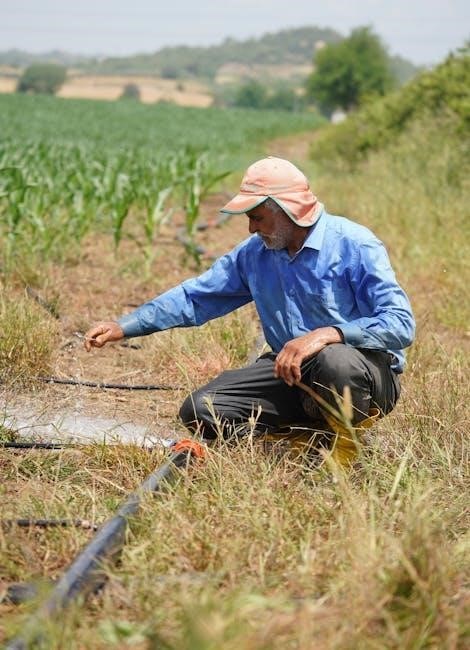On The Go Water Softener Manual: A Comprehensive Guide
This comprehensive guide provides essential information for operating and maintaining your On The Go portable water softener. Whether you’re in a tiny house or RV, this manual helps you enjoy soft water on the go. Follow these instructions for optimal performance and longevity of your system.
On The Go Portable Water Softeners offer a practical solution for those seeking soft, treated water while traveling or living in small spaces. These units are especially popular among RV enthusiasts and tiny house dwellers who desire the benefits of softened water wherever they go. Founded in 2004, On The Go is a leading developer of portable water softening and deionization products.
These softeners reduce the concentration of calcium, magnesium, and other metal cations, addressing the issues caused by hard water. By using an On The Go softener, you can prevent scale buildup, extend the life of your appliances, and avoid rust stains. Furthermore, soft water improves taste and odor, helps with dry skin, and enhances soap lathering.

The convenience of having soft water on the go cannot be overstated. Whether you’re concerned about water quality in different locations or simply prefer the feel of soft water, these portable units provide a reliable solution. They are designed to be user-friendly and effective, ensuring that you can easily set up and maintain your water softening system while on the road.
Benefits of Using Soft Water While Traveling
Traveling with an On The Go water softener provides numerous advantages, enhancing your comfort and protecting your equipment. Soft water eliminates scale buildup in pipes and appliances, extending their lifespan and preventing costly repairs. This is particularly important in RVs and mobile homes, where space is limited and maintenance can be challenging.

Soft water also improves the efficiency of soaps and detergents. You’ll notice better lathering and rinsing, requiring less product to achieve the same results. This not only saves money but also reduces the amount of chemicals released into the environment. Additionally, soft water is gentler on skin and hair, preventing dryness and irritation, which can be exacerbated by frequent travel and varying water sources.
Beyond the practical benefits, soft water enhances the overall travel experience. Enjoy cleaner, better-tasting water for drinking and cooking, regardless of your location. Say goodbye to hard water stains and mineral deposits on fixtures and dishes. With an On The Go water softener, you can enjoy the comforts of home, wherever your adventures take you.
Understanding Water Softening: Removing Hardness
Water softening is the process of removing minerals like calcium and magnesium, which cause water hardness. Hard water can lead to scale buildup in pipes and appliances, reducing efficiency and lifespan. It also interferes with soap and detergent effectiveness, leaving residue on skin, hair, and fabrics.
Water softeners use a process called ion exchange to remove these hardness minerals. The softener contains resin beads that are negatively charged. As hard water flows through the softener, the positively charged calcium and magnesium ions are attracted to the resin beads, replacing them with sodium ions. Sodium does not cause the same problems as calcium and magnesium, effectively softening the water.
The On The Go water softener is designed for portability, making it ideal for RVs and travel. Understanding the science behind water softening helps you appreciate the benefits of using a softener and maintain it properly. Regular regeneration with salt is necessary to replenish the sodium ions on the resin beads, ensuring continued soft water.
Initial Setup and Installation
Before using your On The Go portable water softener, proper setup and installation are crucial for optimal performance. Begin by inspecting all components to ensure they are free from damage. Identify the inlet and outlet connections on the softener unit. Ensure you have the necessary hoses and fittings for connecting the softener to your water source and point of use.
First, connect the water source to the inlet of the softener. It’s recommended to flush the system before first use, this is achieved by turning on the water and flushing the resin dust out. Then, connect the outlet of the softener to the point of application, such as your RV’s water system. Ensure all connections are secure to prevent leaks. The unit doesn’t need salt or regeneration before its first use.
Position the softener on a level surface, away from direct sunlight and extreme temperatures. Avoid placing it in areas where it could be easily damaged. With these initial steps completed, your On The Go water softener is ready for use.
Step-by-Step Usage Instructions
To effectively utilize your On The Go portable water softener, follow these simple steps. Begin by ensuring the unit is properly connected to both the water source and your desired outlet. Verify that all connections are tight and leak-free before proceeding. With the connections secured, slowly turn on the water supply to allow the softener to fill;
Monitor the water flow to ensure it’s consistent. The water pressure and flow rate will depend on the water supply. Once the system is filled, you can start using soft water. Remember, the softener doesn’t require salt or regeneration before its initial use.
As you use the water softener, regularly check for any signs of issues, such as reduced flow or changes in water quality. After a period of use, the softener will need to be regenerated with salt to maintain its effectiveness. Follow the regeneration process outlined in the manual to keep your water softener functioning optimally. Regularly inspect the softener for any wear or damage, ensuring its longevity and performance.
Regeneration Process: Adding Salt
The regeneration process is vital for maintaining the efficiency of your On The Go portable water softener. This process replenishes the resin beads within the unit, which are responsible for removing hardness minerals from the water. To begin, ensure that you have the correct type of salt; table salt is often recommended as it dissolves faster and rinses more easily from the softener.
Unscrew the top of the water softener tank, where you typically add salt. Pour the recommended amount of salt into the tank, following the manufacturer’s guidelines for your specific model. After adding the salt, ensure the cap is securely fastened to prevent any leaks or contamination. The frequency of regeneration depends on your water usage and the hardness of your water source.
Monitor your water softener’s performance and regenerate it when you notice a decrease in water softness. Regular regeneration ensures that your softener continues to provide high-quality, soft water. If you are unsure how to program your softener, consult the quick reference guides or detailed operational and programming manuals.
Emptying the Water Softener Tank
Emptying the water softener tank is essential for managing the weight and portability of your On The Go unit, especially when stowing or removing it from your RV or tiny house. To begin, ensure that the unit is disconnected from any water sources to prevent spillage during the emptying process. Locate the top of the tank, where you typically add salt for regeneration.
Carefully unscrew the top, taking precautions not to damage the threads or sealing components. Once the top is removed, gently tip the tank over to allow the water to drain out. Be mindful not to tip the tank too far, ideally not exceeding 90 degrees, to prevent any resin from escaping or causing damage to the internal components.

Allow all the water to drain completely before resealing the tank. This step is crucial for reducing the overall weight of the unit, making it easier to handle and transport. Remember to securely tighten the top after emptying to avoid leaks when the softener is reconnected and in use. Regularly emptying the tank when not in use can also help prolong the life of the unit.
Troubleshooting Common Issues
Encountering issues with your On The Go portable water softener can be frustrating, but most problems are easily resolved with a few troubleshooting steps. One common issue is reduced water softening effectiveness. This can often be attributed to insufficient regeneration. Ensure you are using the correct type of salt, preferably table salt, as it dissolves faster and rinses more efficiently from the softener. Regular regeneration is essential to maintain optimal performance.
Another potential problem is low water pressure. Verify that the inlet and outlet hoses are correctly connected and not kinked or blocked. Check the water source pressure to ensure it meets the softener’s requirements. If the pressure is adequate, inspect the softener for any internal blockages or debris that might be restricting water flow.
Leaks are also a common concern. Examine all connections and fittings for tightness. Ensure that the O-rings and seals are properly seated and in good condition; If leaks persist, consider replacing the O-rings or seals. If these steps don’t resolve the issue, consult the manual or contact customer support for further assistance.
Maintenance Tips for Longevity
To ensure your On The Go portable water softener provides years of reliable service, consistent maintenance is key. Regularly inspect the unit for any signs of wear and tear, such as cracks, leaks, or damaged fittings. Addressing these issues promptly can prevent more significant problems down the line. After each trip, flush the system to remove any sediment or debris that may have accumulated.
Proper storage is also crucial. When not in use, drain the water softener completely to prevent freezing and potential damage to the resin. Store it in a cool, dry place away from direct sunlight. Before storing, consider sanitizing the unit to prevent the growth of bacteria or mold. Refer to the manual for recommended sanitization procedures.
Use table salt for regeneration, as it dissolves faster and is easier to rinse. Regularly check the salt level and replenish as needed. By following these maintenance tips, you can extend the life of your water softener and ensure it continues to provide soft, clean water wherever you go. Always consult the manual for specific maintenance schedules and recommendations.
Accessing Manuals and Support Resources
To maximize the benefits and lifespan of your On The Go portable water softener, easy access to manuals and support resources is essential. Your primary resource is the comprehensive owner’s manual that accompanies the unit. This manual contains detailed instructions on setup, operation, regeneration, troubleshooting, and maintenance. Keep it in a safe and accessible location for future reference.
If you’ve misplaced your physical manual, digital copies are often available online. Visit the manufacturer’s website and search for your specific model number to download the manual in PDF format. Many manufacturers also offer helpful videos demonstrating key procedures such as regeneration and winterization.

For additional support, check the manufacturer’s website for FAQs, troubleshooting guides, and contact information for customer service. Online forums and communities dedicated to RVing and portable water softeners can also provide valuable peer support and advice. Don’t hesitate to reach out to these resources if you encounter any issues or have questions about your system.
Finding RV Parts, Accessories and Supplies
Maintaining your RV and its water softening system often requires sourcing specific parts, accessories, and supplies. Several avenues exist for acquiring these items, ensuring you can keep your On The Go water softener functioning optimally. Start by checking with authorized dealers of On The Go products, as they typically stock replacement parts and accessories designed specifically for these units.
Online retailers specializing in RV parts and supplies offer a vast selection of items, ranging from replacement hoses and fittings to specialized cleaning solutions and regeneration salt. Websites like RVupgrades are excellent resources for finding a wide array of products. When ordering online, ensure you verify the compatibility of the part with your specific On The Go water softener model.
Local RV dealerships and camping supply stores are also valuable resources. These brick-and-mortar establishments provide the opportunity to physically inspect items before purchase and receive expert advice from knowledgeable staff. Don’t overlook general hardware stores for common plumbing fittings and supplies needed for installation or repairs. Always prioritize quality and compatibility to ensure the longevity and efficiency of your water softening system.
